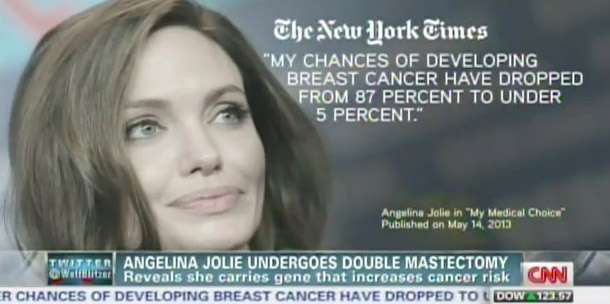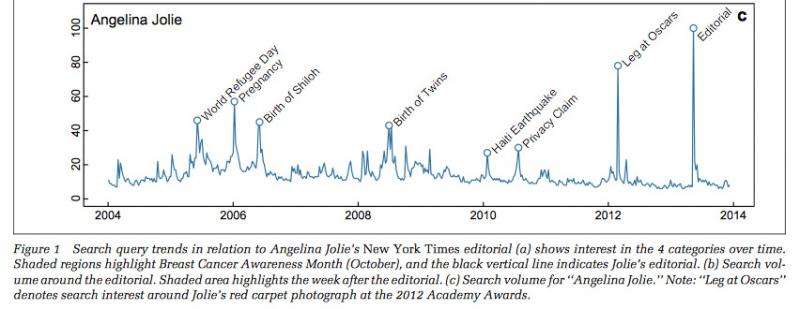The Angelina effect and the mixed blessing of celebrities and risk awareness

"I hope that other women can benefit from my experience", wrote Angelina Jolie of her double mastectomy. She showed great courage and generosity, sharing data and emotions with clarity. It's been just over two years since that essay in The New York Times, and several studies have been published about the impact.
There's no guarantee with celebrities' health revelations. They can do good for others, but they can do harm, too.
The publicity around singer Kylie Minogue's breast cancer diagnosis in her 30s, for example, was associated with a surge in biopsies in women between 25 and 44 years of age for a few months in Australia. There was a surge in screening and biopsies for a few weeks in the UK, too.
But there wasn't an increase in diagnoses of breast cancer. The group of women reacting to the publicity about Minogue were generally too young to benefit from breast cancer screening, so on balance, they seem to have been more harmed than helped.
"The Katie Couric effect" on screening for colorectal cancer in 2000 was reportedly positive – but short-lived. Impact being short-lived is typical, according to a review by Seth Noar and colleagues (2014) of studies of public figures' announcements about cancer made before Jolie's.
What about "the Angelina effect"? It's been studied particularly frequently: I found 5 studies.
Media impact was studied by Kalina Kamenova and colleagues (2014). Kamenova points out that Jolie's announcement came at the time a Supreme Court ruling about patenting and genes was expected.
The BRCA gene test Jolie needed is expensive (or lucrative, depending on your perspective). A company sought to patent the BRCA1 and BRCA2 genes. The Supreme Court decision about gene patenting was handed down a month later. Jolie's announcement and the Supreme Court decision fueled interest in each other.
Kamenova and colleagues studied the content of 103 pieces of elite newspaper coverage of Jolie's choice in Canada, the US and the UK – up to one month after the announcement. Those authors concluded it took an "overwhelmingly positive slant towards Jolie's mastectomy, while overlooking the rarity of her situation".
Internet searching on breast cancer and genetics spiked. But that was over quickly, according to a study by Noar and colleagues (2015). They used Google Trends, correcting for the usual increase in searching over time. They couldn't find a durable effect: "All query categories returned to normal volumes…by the beginning of the second week".
This figure below from Noar's paper is telling, isn't it? Public interest in her mastectomy decision was enormous – but interest in the pose Jolie struck at the 2012 Oscars and its meme was massive too. And most of the peaks of interest across that decade were in her private life.

What information stuck? There have been 2 surveys done shortly after Jolie published her essay: by Dina Borzekowski and colleagues (2014) and Kami Kosenko and colleagues (2015). Kosenko's survey was very small – only 356 people recruited from around the US in a variety of ways that couldn't ensure a particularly representative sample. Most (83%) had heard about Jolie's experience, but there wasn't much impact on people's interest in BRCA testing.
Borzekowski and colleagues surveyed 2,572 adults from a national panel of people interested in participating in research projects from around the US. The authors said that 3 out 4 were aware of the double mastectomy, and the bit of information that "stuck" was how high her risk was beforehand. But knowing about Jolie's experience wasn't associated with increased understanding of breast cancer risk:
These findings suggest that respondents largely interpreted a negative family history as protective against cancer and that exposure to the story appeared to confuse, rather than clarify, an understanding of the relationship between a positive family history and increased cancer risk.
Very few of the women in these studies would have been directly affected by this rare situation, though. The fifth study is the only one that looked at use of genetic and cancer-related services in the UK (Gareth Evans and colleagues, 2014).
In the UK, Jolie's essay coincided with the release of new national guidelines on familial breast cancer. A draft had been released for public discussion in January, with the final release coming at the end of June.
The genetic services had a large increase in referrals for BRCA gene testing. It subsided by the end of the year, having peaked in July. Evans and colleagues concluded that the referrals were appropriate, but caused a strain on resources.
From this patchwork of studies, it certainly looks as though there was an "Angelina effect", and it was overall positive – and perhaps short-lived. But the studies have a fairly narrow focus. They didn't, for example, look for impact on women who are in a similar situation to Jolie, who could be gaining support from her process of informed decision-making and emotional strength.
Jolie's situation was dramatic and exceptional. The studies and announcements in the Noar review tend to be way out of kilter with general cancer risks, too.
Of 20 high-profile cancer events in public figures they pointed to from 2004 to 2012, a quarter were pancreatic cancer: Dan Fogelberg, Steve Jobs, Dan Fogelberg, Randy Pausch, Sally Ride, and Patrick Swayze.
Only 1 out of 20 was a colorectal cancer – Farrah Fawcett's very public struggle with the anal cancer that ended her life in 2009. As extraordinary a phenomenon as that was given how much more common colorectal cancer is than pancreatic cancer, I couldn't find any studies of it.
Of the 19 studies that Noar and colleagues found published between 1978 and 2011, few different cancers and cases were covered. There were 10 on breast cancer, with one of those including lung cancers too, 4 each on pancreatic and cervical cancer, and 1 on colorectal cancer. Researchers are treading repeatedly over the same ground.
I wonder if we are living out at a community level, what we do in our families, too: we discuss some cancers openly and clearly, but others not. As a result, we really don't know our family histories as well as we might think we do.
The Noar review also points to another recurring phenomenon: the impact of celebrities is greater on those who identify with them socially. That's usually someone of similar age, gender, and race. Jolie may have been an exception on race, according to Kosenko's small study.
Mass media interventions are among those that can increase health inequalities. Yet, researchers interested in how to best respond to celebrities' cancer experiences continue to focus on those from more socially advantaged demographics. Even though, for example, socially advantaged women may be overestimating their risk of breast cancer. And women of color who meet criteria for referral for BRCA gene testing may be getting referred less often (Bellcross 2013, Cragun 2015).
Increased cancer screening means more and more people are diagnosed with a dreaded condition that never would have actually caused them illness. It's in the nature of screening. What I've called the prevention illusion can decrease the number of people who die from cancer – while increasing the number of people who suffer from it. A shadow of cancer angst is spreading.
Researchers in this field have not focused on the emotional impact as much as public education on risk. It seems to me, though, for the rest of us, much of our interest in these public announcements may not be only – or even primarily – an information-gathering process. Much of our interest may be more about learning or "rehearsing" how to cope with life-threatening diagnoses.
According to Olav Førde,
Increased risk awareness not only changes the way people think about health, disease and death. More profoundly, and more seriously, it ultimately changes human values, self-identity and our perspective on life.
The "Angelina effect" may be something of a mixed blessing as a public education exercise in risk awareness. Its true power may lie elsewhere.
Postscript: In March 2015, Angelina Jolie wrote that she had now also had both ovaries removed to reduce her risk of ovarian cancer. According to Google Trends, that gained a similar amount of attention to the release of Unbroken, a movie she produced and directed, and her meeting with the Pope – but not as much attention as her marriage in 2014.
More information: "Kylie Minogue's breast cancer: effects on referrals to a rapid access breast clinic in the UK." Breast. 2006 Oct;15(5):667-9. Epub 2006 May 30. www.ncbi.nlm.nih.gov/pubmed/16730988
"Use of breast cancer screening and treatment services by Australian women aged 25-44 years following Kylie Minogue's breast cancer diagnosis." Int J Epidemiol. 2008 Dec;37(6):1326-32. DOI: 10.1093/ije/dyn090
"Angelina Jolie's faulty gene: newspaper coverage of a celebrity's preventive bilateral mastectomy in Canada, the United States, and the United Kingdom." Genet Med. 2014 Jul;16(7):522-8. DOI: 10.1038/gim.2013.199
This story is republished courtesy of PLOS Blogs: blogs.plos.org.

















